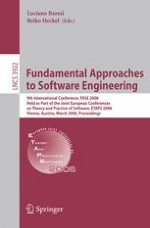ETAPS 2006 was the ninth instance of the European Joint Conferences on Theory and Practice of Software. ETAPS is an annual federated conference that was established in 1998 by combining a number of existing and new conferences. This year it comprised ?ve conferences (CC, ESOP, FASE, FOSSACS, TACAS), 18 satellite workshops (AC- CAT, AVIS, CMCS, COCV, DCC, EAAI, FESCA, FRCSS, GT-VMT, LDTA, MBT, QAPL, SC, SLAP, SPIN, TERMGRAPH, WITS and WRLA), two tutorials, and seven invited lectures (not including those that were speci?c to the satellite events). We - ceived over 550 submissions to the ?ve conferences this year, giving an overall acc- tance rate of 23%, with acceptance rates below 30% for each conference. Congratu- tions to all the authors who made it to the ?nal programme! I hope that most of the other authorsstill founda way of participatingin this excitingevent and I hope you will continue submitting. The events that comprise ETAPS address various aspects of the system devel- ment process, including speci?cation, design, implementation, analysis and impro- ment. The languages, methodologies and tools which support these activities are all well within its scope. Di?erent blends of theory and practice are represented, with an inclination towards theory with a practical motivation on the one hand and soundly based practice on the other. Many of the issues involved in software design apply to systems in general, including hardware systems, and the emphasis on software is not intended to be exclusive.
